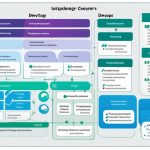Cloud migrations offer organizations the opportunity to streamline their IT infrastructure and optimize processes through automation and configuration. In the realm of cloud networking, automation plays a vital role in reducing operating costs and improving efficiency. Whether utilizing public, private, or hybrid cloud architectures, businesses can leverage cloud automation tools to automate the provisioning, configuration, and management of their cloud-based infrastructure.
When it comes to cloud automation, several essential tools and practices come into play. In this article, we will explore the top cloud automation tools for efficient cloud networking, delve into the difference between cloud automation and cloud orchestration, discuss various use cases and best practices, and ultimately highlight the benefits of implementing cloud automation in your organization’s IT strategy.
Let’s dive in and explore the world of cloud automation tools, cloud networking, IT infrastructure, and configuration.
Top Cloud Automation Tools for Efficient Cloud Networking
When it comes to achieving efficient cloud networking, organizations have several top cloud automation tools at their disposal. These tools enable the automation of critical tasks, such as provisioning and configuration, to streamline and optimize cloud-based infrastructure. By leveraging these tools, organizations can enhance their operational efficiency and reduce manual efforts.
AWS CloudFormation: AWS CloudFormation is a powerful tool that enables the automated provisioning and configuration of resources within an AWS cloud-based infrastructure. It provides a declarative way of defining infrastructure as code, allowing organizations to efficiently manage and deploy complex cloud architectures.
Puppet: As a leader in configuration automation, Puppet offers comprehensive management capabilities for cloud-based infrastructure. It allows organizations to define desired states for their systems, automating the enforcement and configuration of resources. With Puppet, organizations can efficiently manage large-scale cloud environments and ensure consistency across their infrastructure.
Ansible: Ansible is known for its simplicity and ease of use. It provides task-based automation, allowing organizations to automate repetitive tasks and streamline their cloud networking processes. Ansible’s agentless architecture makes it easy to deploy and manage, making it an attractive choice for organizations looking for simplicity combined with effective automation.
Chef: Chef provides a Domain-Specific Language (DSL) for enforcing configuration policies in a cloud-based infrastructure. It allows organizations to define and automate their infrastructure as code, ensuring consistency and repeatability. Chef’s focus on configuration management makes it a valuable tool for organizations seeking fine-grained control over their cloud networking environments.
Kubernetes: While not a traditional configuration management tool, Kubernetes is widely used for automating the deployment and management of containerized applications. With its robust orchestration capabilities, Kubernetes simplifies the process of scaling, managing, and monitoring applications in a cloud-native environment.
These cloud automation tools offer a range of capabilities and benefits for organizations looking to optimize their cloud networking processes. From automated provisioning to configuration management, choosing the right tool can significantly improve efficiency and ensure the smooth operation of cloud-based infrastructure.
| Cloud Automation Tool | Key Features |
|---|---|
| AWS CloudFormation | Automated provisioning and configuration of resources |
| Puppet | Comprehensive management of cloud-based infrastructure |
| Ansible | Task-based automation with ease of use |
| Chef | DSL for enforcing configuration policies |
| Kubernetes | Automated deployment and management of containerized applications |
Cloud Automation vs. Cloud Orchestration: Understanding the Difference
When it comes to managing cloud infrastructure, it is crucial to grasp the distinction between cloud automation and cloud orchestration. While both concepts involve automation, they serve different purposes and operate at different levels.
Cloud automation focuses on automating individual tasks within the cloud environment. It involves the use of automation tools to streamline and expedite specific processes such as provisioning of resources, configuration management, and routine maintenance. Automation tools such as Terraform, AWS CloudFormation, and Azure Resource Manager enable organizations to achieve efficient provisioning and management of cloud resources.
Cloud automation helps eliminate manual effort and minimizes errors by automating repetitive tasks. This allows IT teams to save time, reduce costs, and increase operational efficiency.
Cloud orchestration, on the other hand, takes automation to a higher level by coordinating and managing multiple automated tasks to create a cohesive process or workflow. It involves orchestrating various components and services within the cloud environment to ensure smooth, end-to-end operations. Cloud orchestration tools, like Kubernetes, Apache Mesos, and OpenShift, enable organizations to automate complex workflows, manage dependencies, and ensure scalability and reliability.
Cloud orchestration provides organizations with the ability to automate and manage complex cloud workflows, ensuring that various interdependent tasks are executed in a coordinated manner.
While cloud automation tools focus on automating specific tasks, cloud orchestration tools facilitate the arrangement and automation of multiple tasks to create a seamless and efficient process. Both cloud automation and cloud orchestration complement each other and play vital roles in optimizing cloud operations.
Benefits of Cloud Automation and Orchestration
Cloud automation and orchestration offer several benefits to organizations:
- Efficiency: By automating both simple and complex tasks, organizations can achieve greater efficiency in managing their cloud environments.
- Scalability: Automation and orchestration enable seamless scalability, allowing organizations to handle increasing workloads and adapt to changing business needs.
- Reliability: With automation and orchestration, organizations can ensure consistent and reliable execution of tasks and workflows, reducing the risk of errors.
- Cost Optimization: By automating routine tasks and optimizing resource allocation, organizations can optimize costs and make efficient use of cloud resources.

Understanding the distinction between cloud automation and cloud orchestration is essential for organizations to make informed decisions regarding the use of automation tools. While cloud automation tools focus on individual tasks, cloud orchestration tools provide a higher level of coordination and management for complex workflows. By leveraging the right combination of automation and orchestration tools, organizations can optimize their cloud operations and achieve enhanced efficiency, scalability, and reliability.
Cloud Automation Use Cases and Best Practices
Cloud automation offers a range of use cases and best practices that can enhance IT infrastructure, manage workloads efficiently, enable DevOps work processes, and optimize cloud resources. By implementing these best practices, organizations can maximize the benefits of cloud automation and achieve optimized operations and cost savings.
Provisioning Infrastructure
One of the key use cases for cloud automation is provisioning infrastructure. By automating the process of creating and configuring cloud-based resources, organizations can rapidly scale their infrastructure to meet changing demands. This ensures agility and reduces the manual effort required for resource provisioning.
Managing Workloads
Cloud automation also plays a crucial role in managing workloads effectively. With automation tools, organizations can dynamically allocate resources, scale applications, and implement load-balancing strategies. This enables efficient workload management, ensuring optimal performance and responsiveness.
Enabling DevOps Work Processes
DevOps methodologies rely on automation to streamline software development and deployment processes. Cloud automation tools facilitate the integration of development and operations teams, enabling seamless collaboration and continuous delivery. By automating tasks such as code deployment, configuration management, and testing, organizations can accelerate software development lifecycles and enhance overall efficiency.
Cloud Optimization
Cloud optimization is another critical area where automation can make a significant impact. By automating processes such as resource utilization monitoring, performance optimization, and database management, organizations can ensure that their cloud infrastructure operates at peak efficiency. This leads to cost savings, improved performance, and enhanced user experience.
Cloud Cost Optimization
Optimizing cloud costs is a top priority for many organizations. Cloud automation tools can help in this regard by providing insights and automation for optimizing cloud compute resources. For example, Spot by NetApp offers intelligent automation for managing cloud costs, allowing organizations to leverage spot instances and automate workload placement to achieve cost-effective resource utilization.
| Best Practices for Cloud Automation |
|---|
| Promote visibility across environments |
| Determine the optimal scaling strategy |
| Organize cloud automation with tags |
| Develop a plan for monitoring and optimizing costs |
By following these best practices, organizations can ensure effective implementation of cloud automation and maximize the benefits it offers. Promoting visibility across environments helps maintain a clear understanding of the overall infrastructure. Determining the optimal scaling strategy ensures resources are efficiently allocated based on demand. Organizing cloud automation with tags aids in managing and tracking resources effectively. Finally, developing a plan for monitoring and optimizing costs enables organizations to make informed decisions and continually optimize their cloud spending.
By leveraging cloud automation tools and adopting these best practices, organizations can unlock the full potential of their cloud infrastructure, empowering them to achieve efficient operations, improved resource management, and cost optimization.
Conclusion
Cloud automation tools are essential for achieving efficient cloud networking. By automating key tasks such as provisioning, configuration, and management, organizations can streamline their IT infrastructure and optimize resource utilization.
Implementing best practices is crucial to maximizing the benefits of cloud automation. Promoting visibility across environments allows for better monitoring and control, while determining the right scaling strategies ensures optimal performance and flexibility. Organizations should also focus on optimizing costs by leveraging automation tools and adopting cloud cost optimization strategies.
In summary, choosing the right cloud automation tools and following best practices enable organizations to unlock the full potential of their cloud networking initiatives. By embracing cloud automation, businesses can enhance efficiency, improve scalability, and drive cost optimization, ultimately achieving seamless and efficient cloud networking.
FAQ
What is cloud automation?
Cloud automation refers to the process of automating tasks related to provisioning, configuration, and management of cloud-based infrastructure.
What are some top cloud automation tools for efficient cloud networking?
Some top cloud automation tools include AWS CloudFormation, Puppet, Ansible, Chef, and Kubernetes.
What is the difference between cloud automation and cloud orchestration?
Cloud automation focuses on automating individual tasks, while cloud orchestration involves arranging and automating multiple tasks to create a cohesive process.
What are some use cases and best practices for cloud automation?
Cloud automation can be used for provisioning infrastructure, managing workloads, enabling DevOps work processes, and optimizing cloud resources. Best practices include promoting visibility across environments, determining the optimal scaling strategy, organizing cloud automation with tags, and developing a plan for monitoring and optimizing costs.
How do cloud automation tools help in achieving efficient cloud networking?
Cloud automation tools streamline IT infrastructure by automating provisioning, configuration, and management tasks, helping organizations optimize their cloud resources and achieve efficient cloud networking.



















